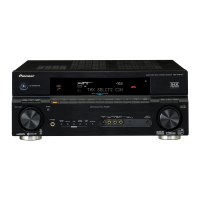
Do you have a question about the Pioneer VSX-1016TXV-K and is the answer not in the manual?
Register your product online for warranty, tips, updates, and newsletters.
Introduction to the receiver's operating manual.
Important safety warnings regarding electrical shock, fire hazards, and proper usage.
FCC compliance statement for Class B digital device operation and conditions.
Serial number location, FCC compliance, and user rights regarding modifications.
Read, retain, heed, and follow all operating and safety instructions.
Ensure proper airflow and avoid blocking vents to prevent overheating.
Proper power source use, grounding, polarization, and cord protection.
Refer servicing to qualified personnel; handle damage and replacement parts correctly.
Install in stable location, avoid water, moisture, heat, and secure mounting.
Proper antenna grounding, lightning protection, and avoiding power lines.
Overview of key features: Advanced Direct Energy design, MCACC, THX, Dolby/DTS, Sound Retriever, HDMI.
List of supplied accessories to verify upon unpacking.
Ensure proper airflow and placement for optimal receiver operation and longevity.
Instructions for correctly inserting batteries into the remote control unit.
Explanation of home theater audio and surround sound concepts.
Basic guide to setting up and achieving surround sound.
Automatic speaker calibration using the included microphone for optimal room acoustics.
Step-by-step guide for performing the automatic MCACC speaker calibration.
Troubleshooting tips for common issues with the Auto MCACC Setup.
Basic steps for playing audio/video sources through the system.
Explanation and use of Basic Phase Control for coherent sound reproduction.
Diagram and identification of rear panel input/output connectors.
Connecting HDMI devices for high-definition audio/video.
Connecting an XM Radio receiver.
Connecting digital audio sources via coaxial cables.
Connecting digital audio sources and recorders via optical cables.
Connecting to other Pioneer components for IR remote control.
Connecting stereo analog audio sources.
Connecting video sources using component video jacks.
Connecting various audio/video sources like DVD, VCR, etc.
Connecting AM and FM antennas for radio reception.
Diagram and steps for connecting a TV and DVD player using various cables.
Connecting satellite/cable receivers and digital TV tuners.
Connecting analog and digital video/audio from recorders and VCRs.
Using component video for superior picture quality and progressive scan.
Connecting source component video outputs to assignable inputs.
Connecting component video outputs to your TV or monitor.
Connecting digital audio sources using optical cables.
Information on the built-in WMA9 Pro decoder for compatible audio playback.
Connecting stereo analog audio sources using RCA jacks.
Using front panel jacks for video, S-video, stereo audio, and optical digital.
Guidance on connecting front, center, surround, and subwoofer speakers.
Properly connecting speaker wires to terminals, ensuring correct polarity.
Instructions for bare wire and banana plug speaker connections.
Recommendations for optimal speaker positioning for best surround sound.
Connecting antennas for optimal radio reception.
Placing speakers according to THX system recommendations.
Connecting external FM and AM antennas for improved signal.
Procedure and precautions for plugging the receiver into a power outlet.
Information on the receiver's switched AC power outlet and its limitations.
Identification and basic functions of front panel buttons and dials.
Detailed explanation of front panel input source, setup, and tuning buttons.
Factors affecting remote control performance and optimal usage.
Explanation of signal, format, sound processing, and speaker indicators.
Understanding volume level and speaker system status indicators.
Indicators for selected listening modes and sleep timer status.
Indicators for Dolby/DTS decoding, video conversion, and SR+ mode.
Buttons for receiver functions like input select, volume, and sound modes.
Using number buttons for tuning and selecting input sources.
Buttons for Sleep, SBch, Analog Attenuator, SR+, Dimmer, and Sound Retriever.
Buttons for tuner editing, station presets, and system setup access.
Arrow buttons for navigation and input buttons for source selection.
Dedicated buttons for controlling TVs and other components.
Buttons for THX, Standard, Advanced Surround, Stereo, and Auto Surround modes.
Buttons for accessing System Setup, Acoustic EQ, and Signal Select.
Understanding the remote's LCD display for setup and control.
Using Auto Surround for automatic source detection and playback.
Overview of listening in surround sound and available options.
Explanation of modes like Pro Logic IIx, Neo:6, and their suitability for different sources.
Details on Dolby Digital EX, DTS-ES, and DTS Neo:6 modes.
Using THX Cinema, MusicMode, and Games Mode for enhanced audio.
Exploring effects like Advanced Movie, TV Surround, and Virtual Surround.
Customizing effect levels for surround modes.
Adjusting Center Width, Dimension, Panorama, and effect levels.
Switching between STEREO and DIRECT playback modes.
Using MCACC EQ settings for room acoustics optimization.
Choosing between AUTO, ANALOG, and DIGITAL input signals.
Configuring SBch ON, AUTO, or OFF for 6.1/7.1 channel playback.
Using virtual surround back channels when rear speakers are not connected.
Chart showing listening modes for different input signals and SBch settings.
Adjusting volume for low-level listening with Midnight and Loudness.
Restoring sound quality to compressed audio files.
Improving dialog clarity and adjusting bass/treble.
Steps for tuning FM/AM radio using automatic and manual methods.
Entering radio frequencies directly using number buttons.
Memorizing and selecting favorite radio stations.
Assigning custom names to saved radio station presets.
Recalling saved radio stations using presets.
Steps to enter and navigate the System Setup menu.
Setting up surround back speakers for Normal, Second Zone, or Front Bi-Amp.
Detailed manual adjustments for speaker setup and EQ.
Adjusting individual speaker levels for optimal balance.
Setting speaker distances for precise delay and surround effects.
Automatically measuring room acoustics for EQ adjustment.
Copying Auto MCACC EQ settings to custom presets.
Manually adjusting EQ settings for custom sound profiles.
Verifying ALL CH ADJUST, FRONT ALIGN, and custom EQ settings.
Detailed settings for speaker size, number, and type.
Specifying speaker size (LARGE/SMALL/NO) and subwoofer presence.
Setting the frequency cutoff for bass frequencies sent to speakers/subwoofer.
Adjusting individual speaker levels for overall system balance.
Setting speaker distances for precise delay and surround effects.
Configuring THX audio settings and identifying THX speaker systems.
Overview of XM Radio service and receiver compatibility.
Steps for connecting the XM Connect-and-Play antenna.
Using XM HD Surround technology for enhanced audio.
Memorizing and recalling XM Radio channels.
Connecting HDMI-equipped components for digital audio/video.
Information on HDMI capabilities and connections.
Connecting 5.1/6.1/7.1 analog audio from DVD players.
Activating analog multichannel inputs for surround sound.
Using surround back terminals for stereo playback in another room.
Connecting speakers using separate terminals for high/low frequencies.
Selecting speaker system A, B, or AB for different listening zones.
Adding external amplifiers to every channel using pre-outs.
Connecting a Pioneer plasma display for enhanced features.
Steps to enable SR+ mode for Pioneer plasma display control.
Configuring input source assignments for digital and component video.
Mapping digital inputs (Coaxial/Optical) to specific components.
Mapping component video inputs to specific components.
Mapping HDMI inputs to specific video sources.
Accessing and adjusting various customized settings.
Adjusting dynamic range for Dolby Digital/DTS soundtracks.
Selecting mono channel playback for dual mono soundtracks.
Adjusting LFE channel signal level to prevent distortion.
Configuring SR+ mode for Pioneer plasma display control.
Enabling or disabling analog video signal conversion.
Recording audio/video from tuner or connected sources.
Using input attenuator to prevent distortion from strong analog signals.
Watching video from one source while listening to another.
Setting the receiver to automatically switch to standby.
Adjusting the brightness of the front panel display.
Setting speaker impedance for 6 Ohm or 8 Ohm speakers.
Restoring all receiver settings to factory defaults.
Assigning preset codes to control external devices.
Manually selecting manufacturer preset codes for components.
Teaching the remote to learn signals from other remotes.
Deleting programmed button settings and restoring defaults.
Erasing all programmed remote control codes.
Checking assigned preset codes for input source buttons.
Controlling one component while using the receiver for another.
Programming sequences for multi-component operations or shutdown.
Starting programmed multi-component operations.
Initiating programmed shutdown sequences for multiple components.
Mapping TV control buttons to specific functions.
Mapping buttons for CD, VCR, DVD, DVR, and cassette decks.
Linking components via SR CONTROL jacks for remote sensor control.
Resolving power-related problems like no power or auto shut-off.
Diagnosing and fixing problems with no sound output or missing channels.
Resolving issues with surround back, subwoofer, or single speaker output.
Diagnosing problems with analog vs. digital sources or noise.
Addressing radio reception noise and DTS CD playback issues.
Fixing issues with no picture, recording errors, or poor video quality.
Resolving Auto MCACC errors, incorrect speaker settings, and data loss.
Resolving problems with dark display, missing indicators, and format display.
Fixing issues with remote control, component control, and SR cable operation.
Resolving picture, sound, and OSD issues with HDMI connections.
Interpreting and resolving XM radio messages like Check Antenna or No Signal.
Explanation of Dolby Digital, EX, Pro Logic IIx, and Dolby Surround.
Explanation of DTS Digital Surround, DTS-ES, Neo:6, and 96/24.
Information on WMA9 Pro discrete surround format.
Using THX modes for music and game audio playback.
Chart showing listening modes for different input signals and SBch settings.
Chart detailing listening modes for multichannel signals and SBch processing.
Technical details for amplifier power, tuner sensitivity, and frequency response.
Power requirements, dimensions, and list of included accessories.
Instructions on how to safely clean the receiver's exterior.
Advice on establishing safe listening levels to prevent hearing damage.
Examples of common sound levels and their potential danger.
Contact details for US and Canadian service, parts, and warranty.
Manufacturer and regional office contact details.

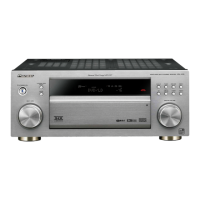
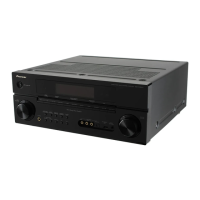
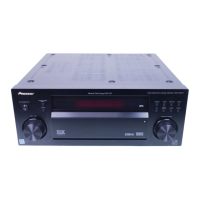
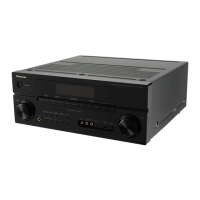

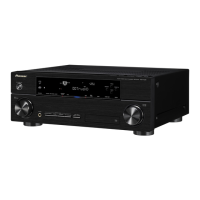
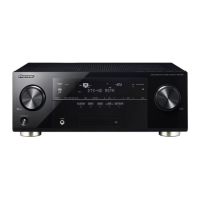
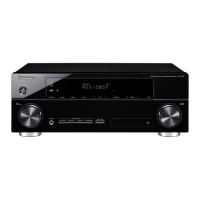
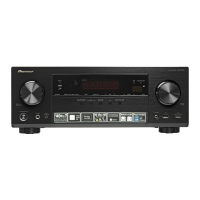
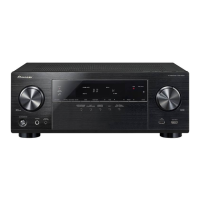
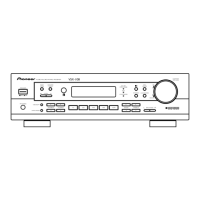
